
https://yourfreetemplates.com/free-machine-learning-diagram/
在開始跑演算法前,會藉由特徵工程提高準確率、優化收斂速度。
常用的特徵工程為以下三種:
將 scale 縮放,達到方便辨識。(常用: 'Normalization' & 'Stadardization)
將與 y 強相關的 x 選擇出來,透過減少互相干擾、或預測能力差的 x 變數,達到加快演算。
常見方法有 SBS、Random Forest...等。
EX. 鐵達尼號中,將 'alone' (與 'sibsp', 'parch' 干擾且重複)刪除。
將與 y 強相關的 x 選擇出來,透過揉合數個 x 變數(將數個變數揉合為單個),達到加快演算。
常見方法有 PCA、TSVD、T-SNE...等。
EX. 鐵達尼號中,將 'sibsp', 'parch' 揉合成 'family_size'。
A. 精度改進。
B. 過擬合風險降低。
C. 加快訓練。
D. 改進的數據可視化。
E. 增加模型的可解釋性。
Overfitting 過度擬合:模型受到訓練資料影響過大,使其預測測試資料時效果不佳。
Underfitting 低度擬合:模型對資料的描述能力太差,無法正確解釋資料。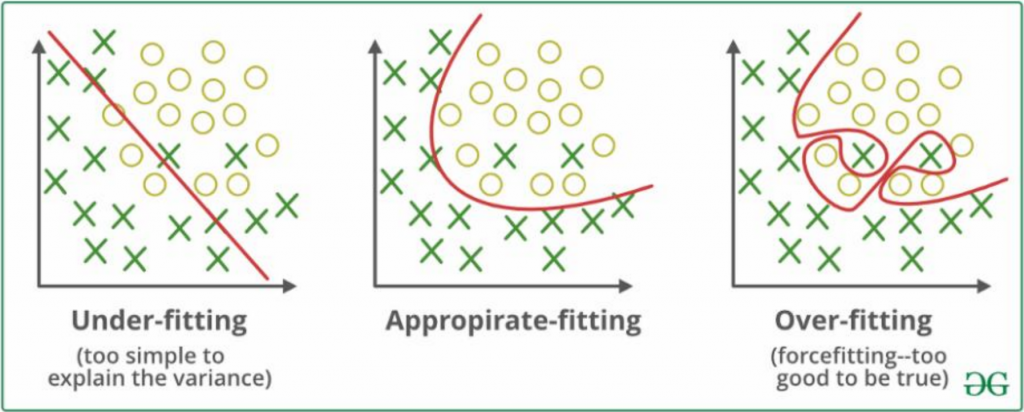
至於造成過擬合的原因,要從偏差或變異說起。
Bias 偏差:指的是預測值與實際值的差距。(打靶打得準)
Variance 變異:指預測值的離散程度。(打靶打得精)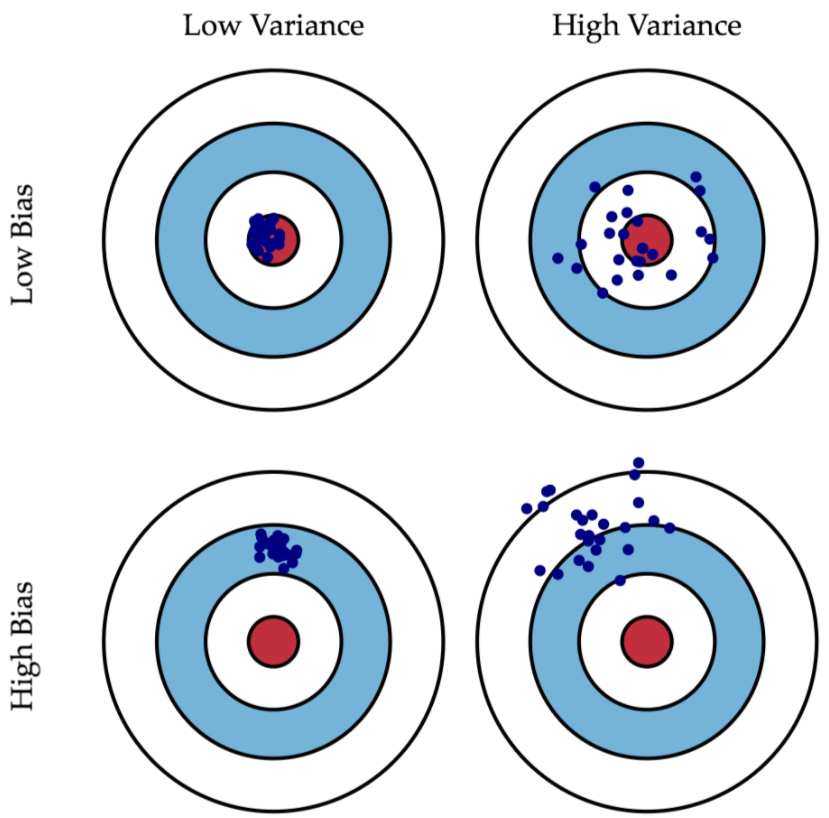
理論上,我們會希望把 Model 訓練的"既準又精",使它可直接描述數據背後的真實規律、意義。
以便後續用它來執行一些描述性或預測性的任務。
然而,實作上就有以下:
1.隨機誤差(Random error)
2.偏差(Bias error)
3.方差(Variance error)。
隨機誤差源於數據本身,基本無法消除。
而 Bias 與 Variance,又跟 Overfitting & Underfitting 的問題息息相關。
理論上,若有"無窮的數據"+"完美的模型"+"究極運算能力",是可以達成的!
實際上,我們的數據跟計算能力都很有限,且模型也不可能完美。
打個比方:建模過程中,若想把 Bias error 降到最低,則須建出非常複雜的模型。
等於讓模型把訓練資料特徵全部硬背,連同隨機誤差也全擬合進模型,使模型失去了泛化能力。
這樣的結果,就稱"Overfitting 過度擬合"。
一旦過擬合,對於未知的資料預測的能力就會很差,造成高 Variance error。
*模型的複雜度 與 模型預測的誤差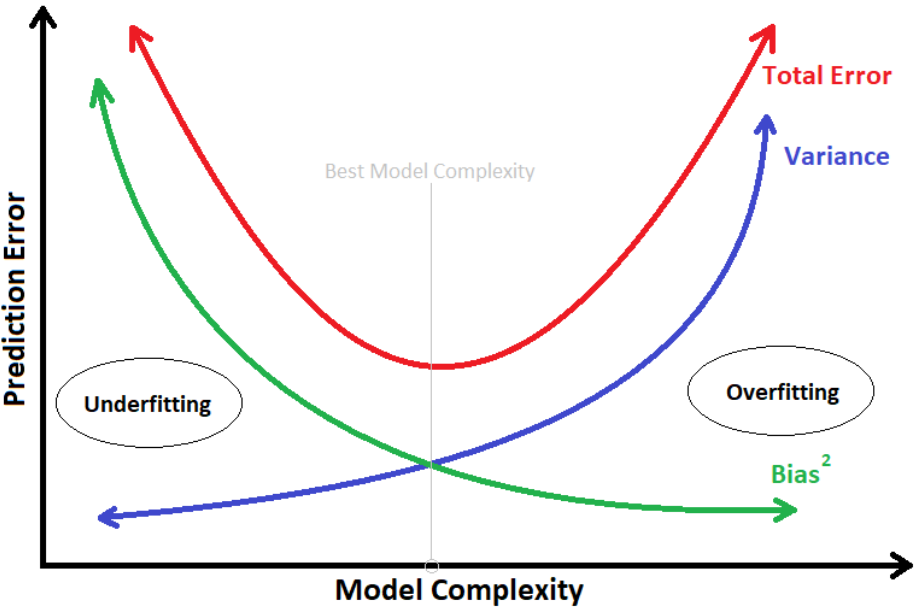
為了避免過擬合,在訓練模型時,會將資料集拆分成 training & testing(training 中再拆分 validation)。
再透過調整超參數(Hyperparameter)來改變模型,以適配不同的資料。
PS. 因特徵縮放在 Day13 已經有稍微提過,以下會著重在特徵選擇 & 特徵萃取。
特徵選擇上,有幾種方式可幫助我們判斷/選取,以下提到 SBS & RandomForest。
以鳶尾花作為例子,見以下
# 1. Datasets
import pandas as pd
import matplotlib.pyplot as plt
import seaborn as sns
from sklearn.datasets import load_wine
from sklearn.linear_model import LogisticRegression
from sklearn.neighbors import KNeighborsClassifier
from sklearn.model_selection import train_test_split
ds=load_wine()
X=ds.data
y=ds.target
X.shape, y.shape
>> ((178, 13), (178,))
# 4. Split Data
X_train, X_test, y_train, y_test = train_test_split(X, y, test_size=0.5)
# 5. Learning Algorithm
# 6. Traing Model
# 7. Score Model
from sklearn.metrics import accuracy_score
def calc_score(X_train, y_train, X_test, y_test, indices):
# Choose Regression
LR = LogisticRegression()
print(indices, X_train.shape)
# Fit model
LR.fit(X_train[:, indices], y_train)
y_pred = LR.predict(X_test[:, indices])
# Score model
score = accuracy_score(y_test, y_pred)
return score
from itertools import combinations
import numpy as np
score_list = []
combin_list = []
best_score_list=[]
# 外迴圈:dim = 1~13
for dim in range(1, X.shape[1]+1):
score_list = []
combin_list = []
# all_dim = (0, 1, 2, 3, 4, 5, 6, 7, 8, 9, 10, 11, 12)
all_dim = tuple(range(X.shape[1]))
# 內迴圈:C 13 取 n,n 從 1~13
for c in combinations(all_dim, r=dim):
score = calc_score(X_train, y_train, X_test, y_test, c)
# 分數加入 score_list,跑合加入 combin_list
score_list.append(score)
combin_list.append(c)
# 找出最高分的項次
best_loc = np.argmax(score_list)
best_score = score_list[best_loc]
best_combin = combin_list[best_loc]
print(best_loc, best_combin, best_score)
# 把所有結果最好的丟進 list
best_score_list.append(best_score)
>> 6 (6,) 0.8539325842696629
>> 5 (0, 6) 0.9325842696629213
>> 278 (8, 9, 12) 0.9662921348314607
>> 65 (0, 2, 4, 6) 0.9662921348314607
>> 120 (0, 1, 5, 8, 9) 0.9662921348314607
>> 71 (0, 1, 2, 5, 7, 9) 0.9662921348314607
>> 59 (0, 1, 2, 3, 6, 9, 11) 0.9775280898876404
>> 66 (0, 1, 2, 3, 5, 6, 9, 11) 0.9775280898876404
>> 107 (0, 1, 2, 3, 6, 7, 8, 9, 12) 0.9775280898876404
>> 232 (1, 2, 3, 4, 5, 6, 8, 9, 11, 12) 0.9775280898876404
>> 68 (1, 2, 3, 4, 5, 6, 7, 8, 9, 11, 12) 0.9775280898876404
>> 7 (0, 1, 2, 3, 4, 6, 7, 8, 9, 10, 11, 12) 0.9662921348314607
>> 0 (0, 1, 2, 3, 4, 5, 6, 7, 8, 9, 10, 11, 12) 0.9438202247191011
將 best_score_list 視覺化:
import matplotlib.pyplot as plt
No = np.arange(1, len(best_score_list)+1)
plt.plot(No, best_score_list, marker='o', markersize=6)

從圖中可知,選 7 項變數(97.7%)來演算結果,與選 11 項(97.7%)相近,
且變數變少,大幅提升運算效率。
當然,若再進一步想增加運算效率,也可選用 3 項變數(96.6%)。
以紅酒分類作為例子,見以下
import numpy as np
import pandas as pd
df_wine = pd.read_csv('https://archive.ics.uci.edu/'
'ml/machine-learning-databases/wine/wine.data',
header=None)
# if the Wine dataset is temporarily unavailable from the
# UCI machine learning repository, un-comment the following line
# of code to load the dataset from a local path:
# df_wine = pd.read_csv('wine.data', header=None)
df_wine.columns = ['Class label', 'Alcohol', 'Malic acid', 'Ash',
'Alcalinity of ash', 'Magnesium', 'Total phenols',
'Flavanoids', 'Nonflavanoid phenols', 'Proanthocyanins',
'Color intensity', 'Hue', 'OD280/OD315 of diluted wines',
'Proline']
print('Class labels', np.unique(df_wine['Class label']))
df_wine.head()

from sklearn.model_selection import train_test_split
# 'Class label' 是 Y
X, y = df_wine.drop('Class label', axis=1), df_wine[['Class label']]
X_train, X_test, y_train, y_test = train_test_split(X, y, test_size=0.5)
from sklearn.ensemble import RandomForestClassifier
# 載入 wine 的 columns
wine_col = df_wine.columns[1:]
# 隨機森林演算法
forest = RandomForestClassifier(n_estimators=500, random_state=1)
forest.fit(X_train, y_train)
# 把每一個變數特徵的重要性列出,從大排到小
ipt = forest.feature_importances_
ipt_sort = np.argsort(ipt)[::-1]
# 依序迭代出重要特徵
for f in range(X_train.shape[1]):
print(f"{f+1:>2d}) {wine_col[ipt_sort[f]]:<30s} {ipt[ipt_sort[f]]:.4f}")
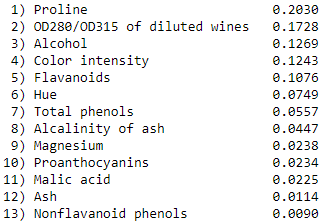
視覺化:
import matplotlib.pyplot as plt
plt.title('Feature Importance')
plt.bar(range(X_train.shape[1]), ipt[ipt_sort], align='center')
# 以 wine_col 代換掉 x 軸的 0~12
plt.xticks(range(X_train.shape[1]), wine_col[ipt_sort], rotation=90)
# 把圖上下縮短
plt.tight_layout()
plt.show()
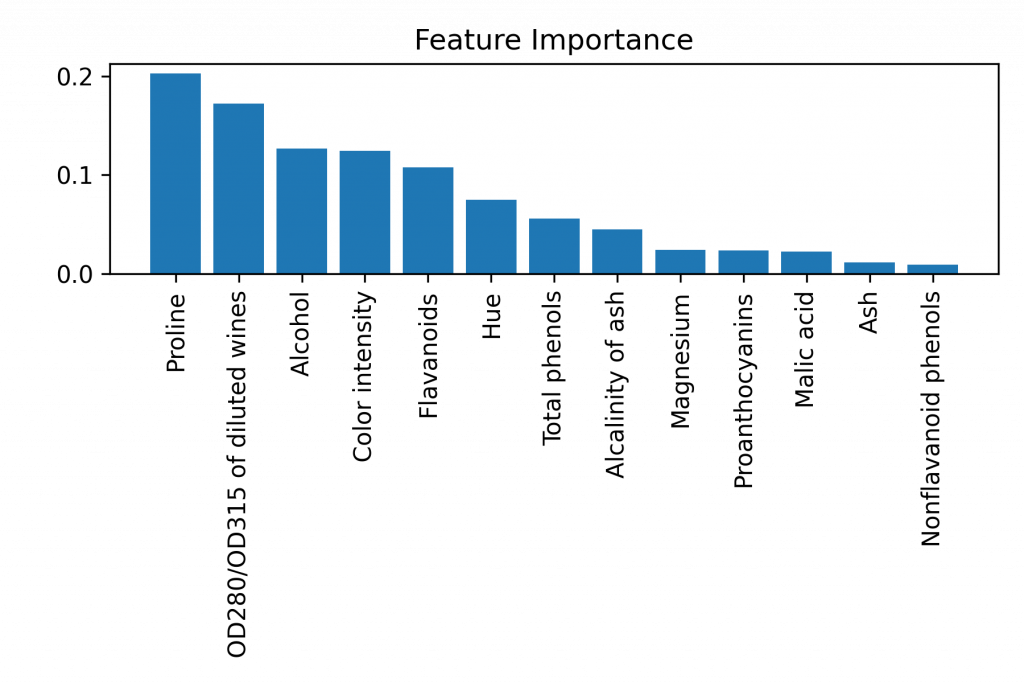
又稱主次因素分析法,是一種條形圖和折線圖的組合,為品質管理上經常使用的一種圖表方法。
其好處是,可以設定一個目標(比方說 80%),將影響最大的幾個因子挑出。
var_exp = ipt[ipt_sort]
# 把 ipt 裡的機率逐個加總(最後肯定會是 1)
cum_var_exp = np.cumsum(var_exp)
>> array([0.20302504, 0.17278228, 0.12686498, 0.12430788, 0.10764943,
0.0748521 , 0.05569083, 0.04471882, 0.02379331, 0.02336044,
0.02253831, 0.01137369, 0.0090429 ])
作圖
# Pareto Chart
import matplotlib.pyplot as plt
# 劃出 bar 條
plt.bar(range(1, 14), var_exp, alpha=0.5, label='individual explained variance') # , align='center'
# 劃出 上升階梯
plt.step(range(1, 14), cum_var_exp, where='mid', label='cumulative explained variance')
plt.ylabel('Explained variance ratio')
plt.xlabel('Principal component index')
plt.legend(loc='best')
plt.tight_layout()
plt.axhline(0.9, color='r', linestyle='--', linewidth=1)
plt.show()
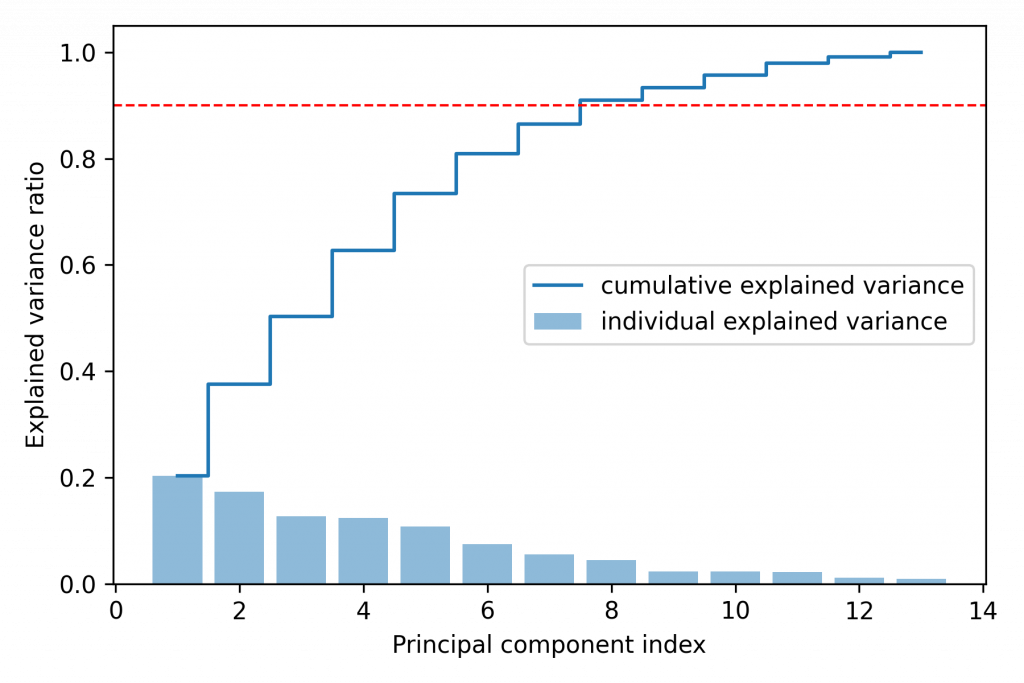
當然還有其他方法可以達到特徵選取,可以參考。
特徵選取擁有數種方法,每種都有其優勢。須根據不同場合及資料類型選用。
但後續的特徵萃取(又稱降維),較能有效加速演算及減少變異偏差。
.
.
.
.
.
請參考鐵達尼號的流程,使用鑽石清理資料來完成演算法。
import pandas as pd
import seaborn as sns
import matplotlib.pyplot as plt
import numpy as np
df = pd.read_csv('diamond.csv')
df.head()
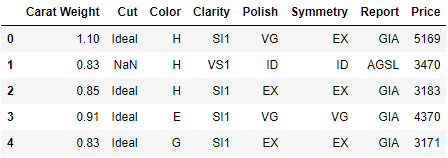
df.info()
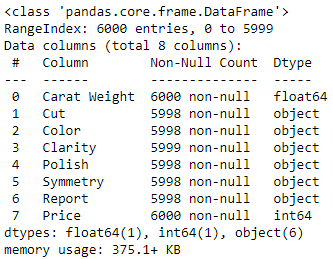
# 確認 NaN
df.isna().sum()
>> Carat Weight 0
Cut 2
Color 2
Clarity 1
Polish 2
Symmetry 2
Report 2
Price 0
dtype: int64
# 使用前一筆填補 NaN
df = df.fillna(method='ffill')
df.isna().sum()
>> Carat Weight 0
Cut 0
Color 0
Clarity 0
Polish 0
Symmetry 0
Report 0
Price 0
dtype: int64
# 印出每個欄位種類個數
for x in df.columns[1:-1]:
print(x)
print(df[x].value_counts())
print()
>> Cut
Ideal 2483
Very Good 2426
Good 708
Signature-Ideal 253
Fair 129
VeryGood 1
Name: Cut, dtype: int64
...(中間略)
Report
GIA 5265
AGSL 735
Name: Report, dtype: int64
# 將明顯是 'Very Good' 但填錯的 'VeryGood' 取代掉
df['Cut'] = df['Cut'].str.replace('VeryGood', 'Very Good')
df['Cut'].value_counts()
plt.figure(figsize=(14, 8))
plt.subplot(2, 3, 1)
# enumerate(): 把 (項次, 內容) 迭代出來,丟進 i 與 x
# 畫出數量圖
for i, x in enumerate(df.columns[1:-1]):
plt.subplot(2, 3, i+1)
sns.countplot(x=x, data=df)

# 劃出 'Carat Weight' 克拉重
# sns.distplot(df['Carat Weight'])
sns.distplot(np.log(df['Carat Weight']))
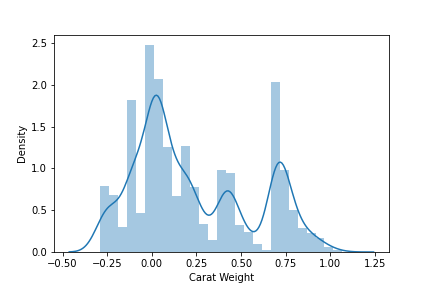
# 'Carat Weight' 無異狀
sns.boxplot(df['Carat Weight'])

# 'Price' 發現有離群點
sns.boxplot(df['Price'])
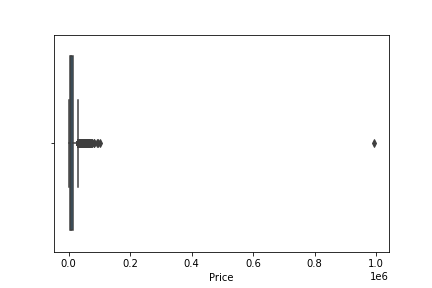
# 把 <= 平均價格+2*價格標準差 以外的異常點排除
df = df[df['Price']<=df['Price'].mean()+2*df['Price'].std()]
sns.boxplot(df['Price'])

餘下的部分就選一個演算法進行跑分即可~
.
.
.
.
.
試著用 sklearn 的資料集 breast_cancer,操作 Featuring Selection (by RandomForest)。
